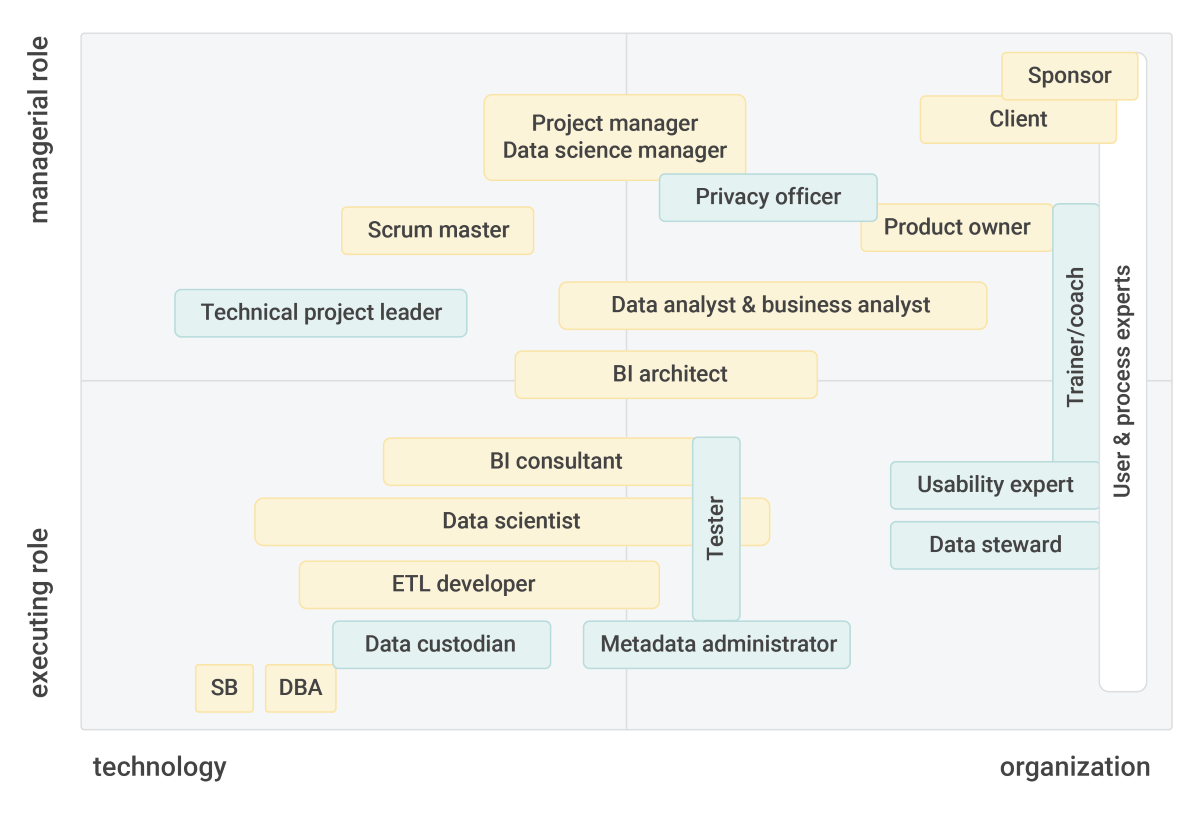Key competencies broken down by function
Automation is always about people. This is certainly true with regard to ‘automating’ decisions and transforming data into ‘actionable intelligence’. The point is that people will use this information and start acting differently. In order to create a proper (well-designed) Intelligent organization, we will need people in certain roles, with specific (behavioral) competencies, experience, and knowledge, first on a project basis and later in the daily operations. In this article, we describe the ideal Business Intelligence project organization. Note that, in practice, we do not always require all roles or we cannot always facilitate all roles, due for example, to budgetary constraints.
The different BI roles
The different roles are also shown in the figure below. They are subdivided into basic roles (yellow) and additional roles (blue).

Figure 1: The different roles that are required for a Business Intelligence project, split into two dimensions Management/Execution and Technology/Business.
Effective BI project teams are characterized – in contrast with conventional IT project teams – by their multidisciplinary nature: business professionals, usability experts, information analysts, and (senior) managers, they all play prominent roles on the Business Intelligence stage:
1. Business Intelligence project manager
The Business Intelligence project manager has knowledge of both business and technology and knows how to bridge the gap between all stakeholders involved in the project.
They understand the politics that are involved in Business Intelligence and they are the main discussion partner for the client when it comes to schedules, budgets, targets, and resources. The project manager often works with multiple clients across multiple departments and therefore should be sure of their ground.
This is especially true when clients tend to go for short-term solutions and fail to opt for a balanced data warehouse architecture. The project manager should prevent these clients from opting for a much less flexible ‘report database’.
Obviously, the project manager has sufficient experience with and knowledge of Business Intelligence architectures, data warehousing, and data models, however, their greatest asset is their ability to weigh up various interests and to unearth the differing arguments.
This allows them to map out the best way of achieving good project results in terms of quality, budget, and return, with satisfied clients and users as a result. The project manager reports to the steering committee and maintains an extensive network of relationships with external consultants, business managers, experts, and suppliers.
Project Manager key competencies
- understands the concept of the Intelligent organization and is capable of easily explaining this concept to project members as well as ‘defending’ it within the organization;
- is able to reconcile short-term and long term interests, individual and organizational interests;
- writes the project plan and monitors the budgets, resources, and schedules;
- is aware of both the main risks and the key success factors of BI projects and manages projects with these in mind;
- has an extensive network and is ultimately responsible for the project result.
2. Business Analyst
The business analyst is the ‘key user’ of the BI system and works in close collaboration with the BI consultant, the client, the sponsor and the users.
They often act as a product director on the client’s side. They create the most important reports and provide – both on request and on their own initiative – ad hoc analysis for managers and knowledge workers. They have a thorough knowledge of the business processes and know the underlying systems well.
The business analyst – often jointly responsible with controllers – determines the indicators and dimensions and makes sure these are unambiguous, consistent, and recognizable. They assist the organization’s management with all types of reports and analysis thereby making good use of the possibilities offered by the various BI tools – from reports to interactive analysis, from visualization to data mining.
Business Analyst key competencies
- has a thorough knowledge of the business and the business processes;
- is communicative, quick-witted, and accurate;
- has in-depth knowledge of various statistical functions and visualizations;
- has a thorough knowledge of and experience with the functioning of different BI tools;
- hands-on mentality.
3. Technical BI project manager
The technical BI project manager mainly focuses on technology and on efficient implementation of the plans once these are accepted.
They control the project on an operational level and they manage the BI architect, the Business Intelligence consultant, the ETL developer, and the system administrators. Often, they are a working supervisor. In smaller projects, the technical project manager often also takes on the roles of project manager and/or architect.
Technical project leader key competencies
- Makes sure that the project plan is efficiently implemented and monitors the progress and quality of the project;
- has a very sound technical understanding of technologies, tools and methods and is able to take decisive action quickly, when necessary;
- is quality-conscious but has a certain pragmatism;
- has hands-on experience with various Business Intelligence tools.
4. Business Intelligence consultant
The BI consultant is the link between the technical and business roles, at an operational level. They translate the information requirements into technical specifications and are responsible for the final changes in the functional design.
The Business Intelligence consultant works closely together with the business analyst, the ETL developer and the Business Intelligence architect. They are generally responsible for the design, the construction, and the maintenance of the data marts and data cubes and they ensure that all essential analysis functionality is embedded.
BI consultant key competencies
- Knows and comprehends the possibilities of BI tools in every detail;
- has a thorough knowledge of SQL, relational databases, OLAP, and MDX;
- has knowledge of analytical, statistical, and relative time functions;
- is communicative and decisive.
5. Business Intelligence client
The client (or business manager) determines both the scope and the business case for BI and does this together with the users, the business analyst and the project manager.
They approve (or reject) the plan of action and provide the budget. They ensure the availability of resources within the organization and have sufficient knowledge of the overall possibilities of Business Intelligence, data warehouses, KPIs, and portals.
They make sure that major course changes are pre-discussed and agreed upon and they are the chairperson of the steering committee. Often, the client is also one of the main sponsors of the project. Large projects often appoint a so-called ‘delegated client’ – usually the information manager – who represents the client with regard to operational issues.
Client key competencies
- Has sufficient general knowledge of (relationships in) business operations;
- understands the possibilities Business Intelligence offers for the business and for the organization as a whole;
- is well aware of the key success factors of BI and ensures that these success factors are being realized in the best possible way;
- keeps an eye on the big picture and is decisive.
6. ETL developer
The ETL developer designs and develops the ETL processes for the data warehouse – or makes sure that it is being done.
ETL developer key competencies
- Has extensive knowledge of SQL and databases;
- is inventive;
- is an expert in the field of ETL tools;
- is a software engineer who focuses on aspects such as maintainability, scalability, performance, and so forth;
- works meticulously and is tenacious.
7. Business Intelligence sponsor
The Business Intelligence sponsor is a future user of the Business Intelligence system who usually appears at the time the possibilities of the Business Intelligence system take shape or have already (partially) been established.
In most cases, the sponsor is a member of the management team or even of the Board of Directors. The sponsor plays an important role in projects that exceed the boundaries of departments or business units and in which different interests must be taken into account. They support the concept of a single version of the truth.
Together with the business analyst, the sponsor designs the initial integral reports and analyses and does this with a certain ease. Where necessary, they promote the Business Intelligence system within the management team and at lower management levels. They have a decisive role in the steering committee, particularly when it comes to determining the future increments and the actual use of information and knowledge in the organization by ensuring that the management information is embedded in the PDCA cycle at different levels.
Sponsor key competencies
- Recognizes the importance of Business Intelligence for the organization in the areas of performance management, innovation, and organizational development;
- is enthusiastic and able to ‘sell’ the BI system within the organization;
- takes action and has excellent management skills.
8. Database Administrator (DBA)
The Database Administrator (DBA) makes sure that the databases and the data models are created on the computer systems and monitors the growth of the data.
They alert the organization if actions are needed with regard to data (growth). They also monitor – usually in close consultation with the system administrators – the processing of the data warehouse and warn the BI project manager if something goes wrong.
Where necessary, they resolve the issue and reload the data warehouse. The DBA also takes care of the monitoring of the response times of reports and analyses and works with the BI consultant in order to – if necessary – add aggregations or indexes. Lastly, the DBA ensures the timely transfer of historical data from the data warehouse to an archive.
DBA key competencies
- Has extensive knowledge of SQL, indexes, relational databases, and OLAP;
- is an expert in database-tuning;
- is proactive and works in a disciplined way and in accordance with procedures.
9. Business Intelligence architect
The Business Intelligence architect translates the basic principles of Business Intelligence, the business requirements and the information needs into a future-proof data warehouse (and/or portal) architecture.
It is very important that the architecture be future-proof because the return on BI systems generally increases as more and more source systems are connected to it and when it supports additional business processes. The architect thus has a crucial role when it comes to the long-term interests of Business Intelligence and may therefore be a bit difficult when dealing with BI project managers or clients who tend to focus on the short term.
The architect has a thorough knowledge of the main IT technologies and architectures and is able to provide generic solutions, structures, and data models quickly. They do not operate individually and are very creative and communicative.
BI architect key competencies
- Is quirky and creative and has a healthy dose of persuasiveness and communication skills;
- is familiar with the latest IT developments and more specifically with BI technologies and methods for data warehousing, EAI, and portals;
- has detailed knowledge of the approaches, principles, and perspectives of ‘gurus’ in the fields of Business Intelligence, application integration, metadata, and data warehousing;
- is able to ‘defend’ the chosen architecture on the basis of practical and conceptual arguments;
- thinks and acts both in the abstract and generally;
- has in-depth knowledge of the possibilities (and functions) of SQL and relational databases;
- has knowledge of dimensional modeling using star schemas, snowflake schemas, and Data Vaults.
10. System administrator
The system administrator both installs and configures the hardware and Business Intelligence-software and monitors the availability of the systems and services.
They also control and monitor both the system load and the performance. Lastly, the system administrator ensures reliable user authentication as well as – together with the DBA – the authorization of the various components of the BI system.
System administrator key competencies
- Has thorough knowledge of operating systems and system & web services;
- has general knowledge of the infrastructural side of BI tools, ETL tools, and portals;
- is proactive and works in a disciplined way and in accordance with procedures.
11. Business Intelligence user
Business Intelligence users exist both at operational and executive level. After all, BI systems serve all levels of the organization.
At the lower levels, we find both the subject matter experts and the process experts, who can tell us ‘everything’ about the benefit of processes at different stages, how these processes run, and what dependencies and exceptions exist. At the higher levels, we find the managers.
They primarily explain and manage the correlations between processes and the associated indicators. The user is often also the tester and has an important voice in the acceptance of the BI system.
User key competencies
- Has detailed knowledge of business operations and processes;
- understands what reporting and analyzing entails;
- uses indicators for line management;
- communicates the numbers;
- develops standards for the key indicators and regularly evaluates and adjusts these;
- is communicative and open.
12. Additional Business Intelligence roles
These roles are necessary in particular in the larger BI projects:
- Trainer/coach: assists users in obtaining maximum output from the BI system, provides training at several levels, and must have knowledge of the tools for BI reporting and analysis. Good trainers and coaches devote sufficient attention to the use and application of information and knowledge with regard to the tasks and responsibilities of the users. They train and coach managers in setting up and securing a PDCA cycle.
- Metadata manager: defines and manages the metadata in the project and ensures that this is both filed and accessible for users, developers, and designers. Works in close collaboration with both the database administrator and the data steward.
- Data steward: monitors the quality of data from a business angle and submits proposals for improving data quality. If relevant, they develop policies regarding the quality of data, often in cooperation with the metadata manager and the business analyst.
- Tester: is responsible for the reliability of the processing of the BI system and initially tests whether the system contains the correct figures. They continue to do this on a regular basis. Provides support in devising and implementing monitoring mechanisms to (automatically or procedurally) verify the reliability of the BI system. Facilitates the EDP auditor and/or the accountant during the yearly calibration of the BI system.
- Usability expert: this expert in the fields of psychology, usability, and ergonomics is concerned with the ease of use of the BI system and provides the business analyst with the necessary ‘input’ with regard to graphics and visualizations. Moreover, they ensure that the BI system is in line (now and in the future) with users’ tasks, responsibilities, and personal preferences.
In smaller BI projects, we can easily combine some of these roles. We could combine the roles of technical project manager and project manager, the BI consultant and the trainer, or the client and the sponsor. In large projects, these roles are usually not combined. In fact, we then even add some of the additional roles – metadata manager, usability expert, and so forth – to the project team.
A multidisciplinary project team
For a multidisciplinary project team to function properly, it is necessary that adjacent roles have sufficient knowledge of each other’s problems, experiences, ambitions, plans, and expertise. Each role should be able to communicate easily – speak each other’s language – with its adjacent roles in order to quickly ‘change gear’ and take action. This should be the main focus of the project manager, in addition to compiling an expert team –, particularly at the start of the project. This aspect is particularly important because, in the world of Business Intelligence, there are many different ideas with respect to the architecture and the most suitable data model. It is the task of the project managers to bring these different ideas to light and then to work towards a shared vision.




Responses
very good explanation. I am now doing a Business Intelligence training course and have recommended this article to all my colleagues. It clarifies the roles and other aspects related with a project in Business Intelligence. Thank you